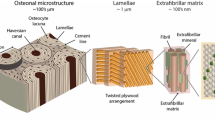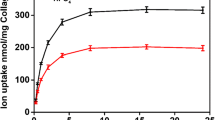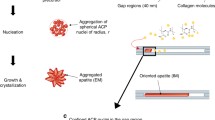Abstract
Sheep bone collagen, rat tail tendon collagen and apatite seeds were used in a model system to study nucleation catalysis and mineral deposition in a metastable calcification buffer.
Sheep bone collagen was shown to be a good nucleation catalyst, while earlier experiments have shown that rat tail tendon collagen was a very poor catalyst.
The rapid phase of apatite deposition in the collagen was terminated as soon as a mineral content of not more than 50–60 per cent was reached, although the buffer was still highly supersaturated.
The results suggest that the amount of mineral deposited in such a model system is regulated by factors similar to those operating in biological calcification.
Résumé
Nous avons utilisé de la collagène d'os de mounton et de tendons de queues de rats et des cristaux d'apatite pour étudier dans un système modèle la catalysation de la nucléation et la déposition de minéral dans un tampon métastabile.
La collagène d'os de mouton se trouvait être un bon catalysateur, tandis que des expériences antérieures ont démontré que la collagène de tendons de queues de rats était un catalysateur très faible.
Le phase rapide de la déposition de l'apatite dans la collagène se termine aussitôt que le contenu du minéral a attaint au plus 50 à 60 pour cent, bien que la supersaturation du tampon est encore bien èlevée.
Les résultats montrent que dans un tel système modèle la quantité du depôt minéral est réglée par des facteurs semblables à ceux qui opèrent pendant la calcification biologique.
Zusammenfassung
Kollagen aus Schafsknochen und Rattenschwanzsehnen und Apatitkeime wurden verwendet in einem Modell-System zur Untersuchung der katalytischen Nukleation und der Fällung von Mineral in einem metastabilen Calciumphosphatpuffer.
Kollagen aus Schafsknochen war ein guter Katalysator für die Nukleation, während in früheren Versuchen sich herausstellte, daß Rattenschwanzkollagen ein ganz schlechter Katalysator ist.
Die schnelle Phase der Apatitfällung im Kollagen war beendet, wenn der Mineralgehalt bis zu 50–60% angestiegen war, obwohl der Puffer noch stark übersättigt war.
Die Resultate weisen daraufhin, daß die Menge des gefällten Minerals in einem solchen Modell-System von ähnlichen Faktoren reguliert wird wie die biologische Verkalkung.
Similar content being viewed by others
References
Bachra, B. N.: Some molecular aspects of tissue calcification. Clin. Orthop. Rel. Res.51, 199–222 (1967).
—,A. Dauer, andA. E. Sobel: The complexometric titration of micro and ultramicro quantities of calcium in blood serum, urine and inorganic salt solutions. Clin. Chem.4, 107–119 (1958).
Bachra, B. N., andH. R. A. Fischer: Calcification in model systems. Proc. of the Fifth European Symp. on Calc. Tissues, Bordeaux 1968, p. 53–58.
Bachra, B. N., andA. E. Sobel: Calcification XXVII. Collagen transformation under influence of calcium and phosphate ions. Proc. Soc. exp. Biol. (N.Y.)102, 314–317 (1959).
——, andJ. W. Stanford: Calcification XXIV. Mineralization of collagen and other fibers. Arch. Biochem.84, 79–95 (1959).
—, andO. R. Trautz: Carbonic anhydrase and the precipitation of apatite. Science137, 337–338 (1962).
——, andS. L. Simon: Precipitation of calcium carbonates and phosphates. I. Spontaneous precipitation of calcium carbonates and phosphates under physiological conditions. Arch. Biochem.103, 124–138 (1963).
Fiske, C. H., andY. Subbarow: The colorimetric determination of phosphorus. J. Biol. Chem.66, 375–400 (1925).
Glimcher, M. J., A. J. Hodge, andF. O. Schmitt: Macromolecular aggregation states in relation to mineralization: The collagen-hydroxyapatite system as studied in vitro. Proc. nat. Acad. Sci. (Wash.)43, 860–867 (1957).
—, andE. P. Katz: The organization of collagen in bone: the role of noncovalent bonds in the relative insolubility of bone collagen. J. Ultrastruct. Res.12, 705–729 (1965).
McLean, F. C., andM. R. Urist: Bone. An introduction to the physiology of skeletal tissue. Chicago University Press 1961.
Neuman, W. F., andM. W. Neuman: The chemical dynamics of bone mineral. Chicago University Press 1958.
Sobel, A. E., M. Burger, andS. Nobel: Calcification XXI. Detection of nuclei of crystallization in rachitic cartilage. Proc. Soc. exp. Biol. (N. Y.)99, 341–344 (1958).
Author information
Authors and Affiliations
Rights and permissions
About this article
Cite this article
Bachra, B.N., Fischer, H.R.A. Mineral deposition in collagenin vitro . Calc. Tis Res. 2, 343–352 (1968). https://doi.org/10.1007/BF02279222
Received:
Issue Date:
DOI: https://doi.org/10.1007/BF02279222




